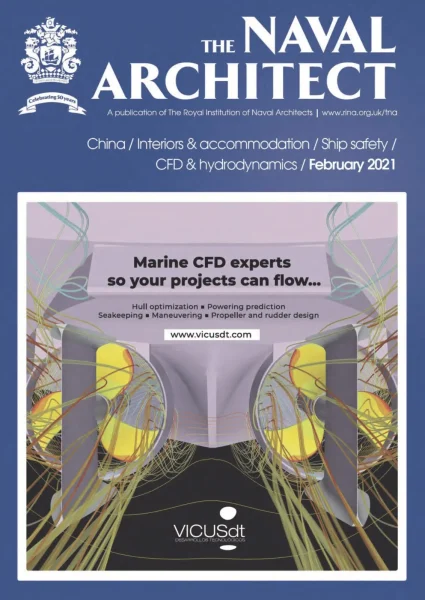This month the CFD special of The Naval Architect magazine publishes an article on our methodology for understanding the hydrodynamic interactions between the components of a ship propulsion system. CFD tools allow us to analyze the complex hydrodynamic interaction happening between rudder, propeller, and hull, critical for good propulsive efficiency and quiet propulsion.
If you want to know more about the benefits of CFD optimization, we invite you to read our article below.
Ship propulsion “in behind” optimisation by CFD

The entire shipbuilding industry is aware of the market demands for more efficient, silent, and comfortable ships which must be developed in increasingly shorter periods. Shipyards, shipowners, and ship designers must adapt to these challenges by using the most up-to-date tools to optimize the performance of their vessels. By making the right decisions from the earliest stages such as conceptual design, design problems can be prevented that otherwise would follow the ship throughout its operational life. The recent development of new and more powerful CFD numerical simulation tools and increased calculation capacity has allowed an evolution in the simulation possibilities and a much more dynamic approach to the design spiral.
VICUSdt has developed its own methodology for the ship hull and propulsion system optimization that makes it possible to shorten times in the initial phases of the project and to quantify more precisely the interaction between the different components. If we evaluate, for example, the development of an actual multipurpose (MPP) cargo ship project and focus on the “behind” optimization of the stern body, propeller and rudder using CFD, we can highlight the following main interactions between the different components:
UPSTREAM PROPELLER
Leaving aside the resistance, the ship wake is the main effect of the hull upstream the propeller. A good uniformity of the wake allows to optimize the design of the propeller in terms of its area, pitch distribution and profiles, carrying out a less conservative design. CFD analysis with rotating propeller makes it possible to see the effect of changes in the stern shape almost in real time on the propeller, both for performance and cavitation.
It is still common in the industry to use averaged axial wake values to determine the design of a propeller. But with this methodology it is relatively easy and cost effective to be able to evaluate the wake from its axial, radial and tangential components affected by the propeller itself, which influence the propulsive coefficients (performance).
The swirl (rotation) of the fluid generated upstream the propeller, is easily assessed with the CFD code and manipulated by varying the geometries, being able to improve the performance of the propeller indirectly.
Thrust deduction accounts for the propeller thrust percentage which is lost while operating behind the ship. This important parameter can be modified with the position of the propeller relative to the hull and the design of the propeller. Parameters such as rake or diameter are key. Sometimes an increase in diameter leads to an improvement in performance that is reduced by a parallel increase in suction. Integrating the pressures on a specific area of the stern makes it possible to quantify small changes in hull and propellers from the suction point of view.
PROPELLER PLANE
With regards to the propeller, the traditional design process uses a wake velocity field obtained from a towing tank test or CFD already given without the possibility of making changes without incurring in higher costs (new tests). The “behind” optimization allows us to dynamically design the propeller while modifying the hull and quantifying the result in terms of absorbed power, speed, or cavitation volume.
It is very common to have a design criteria that requires a compromise solution, such as obtaining high performance for consumption and / or speed but without penalizing noise (comfort). With this methodology it is feasible to determine the best solution suiting all aspects.
As the conditions of comfort and noise in ships are more and more demanding, at present it is not possible to leave cavitation to chance, which many projects cannot afford to evaluate due to budget reasons. CFD analysis brings the opportunity of providing this type of analysis for a wider range of owners and shipyards interested in delivering a higher quality end product.
Cavitation shows up in various ways on the propeller, affecting the noise and vibrations generated by the propulsion of the ship and in more severe cases, the integrity of the propeller (erosion) and other components.
Most types of cavitation whether they are sheet, tip vortex cavitation, hub vortex or pressure face cavitation are evaluated during design and corrected at no additional cost for the customer.
DOWNSTREAM PROPELLER
Hydrodynamic forces and moments on the rudder can be monitored during the calculation, either in transit navigation or during maneuvers. These forces and moments should be evaluated either with the rudder at 0 degrees angle or with small rudder angles as the ship spends most of its life navigating with small angle corrections due to the autopilot.
The rudder blade affects upstream the propeller, locally modifying the advance ratio (J), thus affecting its performance. Likewise, the rudder blade recovers part of the rotational energy of the propeller downstream, the profiles can be adapted to recover part of that energy, also applying solutions such as fins or bulbs. The CFD analysis of the forces and pressure fields in the different areas of the rudder allow us to have a clear picture of the areas to improve.
OVERALL INTERACTION
In summary, the propulsion of the ship is a complex system in which the interaction between the different parts is critical for a good result. Analyzing each component individually results in suboptimal powertrains. A more technically complex but cost-effective solution, in comparison with the overall ship cost, is worth it for a successful project.
“The Naval Architect Magazine” is a prominent publication in the field of naval architecture and maritime engineering. It’s a professional magazine that provides insights, news, and in-depth analysis on various aspects of ship design, construction, and operation. The magazine covers a wide range of topics relevant to naval architects, marine engineers, and professionals in the maritime industry, including the latest technological advancements, shipbuilding trends, maritime regulations, and sustainability issues.
Published regularly, “The Naval Architect Magazine” serves as an important resource for keeping professionals in the maritime sector informed about the latest developments and challenges in their field. It often features articles written by experts in naval architecture and related disciplines, offering readers both technical information and industry perspectives. The magazine is typically aimed at industry professionals, academics, and anyone with an interest in naval architecture and maritime engineering.
Published by the Royal Institution of Naval Architects (RINA) in London, this magazine has a significant history as a key publication in naval architecture and maritime engineering. Established along with RINA in 1860, it has been a vital source of knowledge, sharing developments, research, and best practices in the field. The magazine has evolved with the maritime industry, documenting advancements from the steam and steel age to modern digital and sustainable technologies. It serves as a platform for naval architects, researchers, and industry experts worldwide, offering a blend of technical and industry insights, and remains an essential resource for professionals in maritime sectors.
